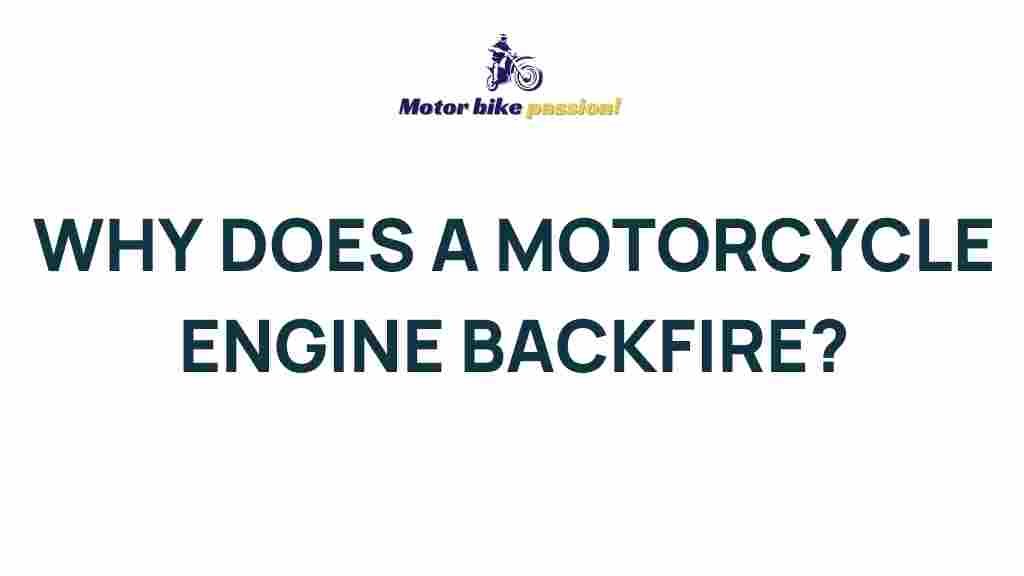Unveiling the Mystery: Why Motorcycle Engines Backfire
Motorcycle enthusiasts often revel in the thrilling sound and experience of riding their machines. However, one phenomenon that can cause confusion and concern among riders is the backfire of motorcycle engines. Understanding why backfires occur is crucial for effective troubleshooting and maintenance. In this article, we will delve into the reasons behind motorcycle engine backfires, how they relate to various components such as the exhaust, spark plug, fuel, and ignition systems, and provide you with essential tips for troubleshooting and maintenance.
What is a Backfire?
A backfire is an explosion that occurs in the engine or exhaust system of a motorcycle, producing a loud popping sound. This can happen during acceleration or deceleration and is often alarming for both the rider and bystanders. While occasional backfiring might not indicate a serious issue, frequent occurrences should prompt a closer inspection of the motorcycle’s engine and related systems.
Common Causes of Motorcycle Engine Backfire
There are several factors that can lead to a motorcycle engine backfire. Understanding these causes can help in effective troubleshooting:
- Rich Fuel Mixture: When the air-fuel mixture is too rich (too much fuel and not enough air), it can lead to incomplete combustion, resulting in backfires.
- Lean Fuel Mixture: Conversely, a lean mixture (too much air and not enough fuel) can cause backfires, particularly during deceleration.
- Faulty Spark Plugs: Spark plugs that are worn, dirty, or malfunctioning can fail to ignite the fuel properly, leading to backfiring.
- Exhaust Leaks: Any leaks in the exhaust system can allow exhaust gases to escape prematurely, which may cause backfiring.
- Ignition Timing Issues: If the ignition timing is off, it can cause the engine to misfire, leading to backfiring.
Step-by-Step Process to Diagnose Backfiring Issues
To effectively troubleshoot motorcycle engine backfires, follow this step-by-step process:
Step 1: Check the Spark Plugs
The first step in troubleshooting backfiring is to inspect the spark plugs. Here’s how to do it:
- Remove the spark plugs using a socket wrench.
- Inspect them for signs of wear, carbon buildup, or damage.
- Replace any faulty spark plugs with new ones that match the manufacturer’s specifications.
Step 2: Examine the Fuel System
A well-functioning fuel system is vital for optimal performance. Follow these steps:
- Check the fuel filter for clogs and replace it if necessary.
- Inspect the fuel lines for leaks or damage.
- Ensure that the carburetor or fuel injectors are clean and functioning correctly.
Step 3: Inspect the Air Filter
A clean air filter is crucial for maintaining the correct air-fuel mixture. To inspect it:
- Remove the air filter cover and take out the air filter.
- Clean or replace the air filter as needed, ensuring proper airflow into the engine.
Step 4: Check the Exhaust System
Exhaust leaks can significantly affect engine performance. Here’s how to check:
- Inspect the exhaust pipes and connections for signs of rust or damage.
- Listen for hissing or popping sounds that may indicate a leak.
- Seal any leaks with appropriate exhaust repair materials.
Step 5: Review Ignition Timing
If all else checks out, the ignition timing may need adjustment:
- Consult your motorcycle’s manual for ignition timing specifications.
- Use a timing light to check if the ignition timing is within the specified range.
- Adjust the timing as necessary, ensuring all components are in good condition.
Maintenance Tips to Prevent Backfiring
Regular maintenance is essential to prevent backfires and keep your motorcycle running smoothly. Here are some tips:
- Routine Inspections: Regularly check spark plugs, fuel systems, and the exhaust. Catching issues early can prevent backfiring.
- Keep Fuel Fresh: Use high-quality fuel and avoid letting it sit in the tank for extended periods. Old fuel can lead to combustion issues.
- Regular Tune-Ups: Schedule periodic tune-ups with a qualified mechanic to ensure all systems are functioning optimally.
- Monitor Riding Habits: Avoid rapid acceleration or deceleration, which can stress the engine and lead to backfiring.
- Use Quality Parts: When replacing engine parts, opt for quality components that meet manufacturer specifications.
When to Seek Professional Help
While many backfiring issues can be resolved through DIY troubleshooting and maintenance, there are situations where professional assistance is warranted:
- If you are uncomfortable performing maintenance tasks yourself.
- When the problem persists after your troubleshooting efforts.
- If you suspect serious engine damage or issues beyond basic maintenance.
In such cases, it’s best to consult a professional motorcycle mechanic who can provide a thorough diagnosis and repair services.
Conclusion
Understanding why motorcycle engines backfire is essential for any rider looking to maintain their machine effectively. By paying attention to components such as the exhaust, spark plug, fuel, and ignition, you can troubleshoot and prevent backfiring issues. Regular maintenance, combined with vigilant observation of your motorcycle’s performance, will help ensure a smooth and enjoyable riding experience.
For more information on motorcycle maintenance and troubleshooting, you can visit this helpful resource. Additionally, understanding the intricacies of your motorcycle engine can enhance your riding experience and prolong the life of your beloved machine. Happy riding!
This article is in the category Maintenance Tips and created by MotorBikePassion Team
